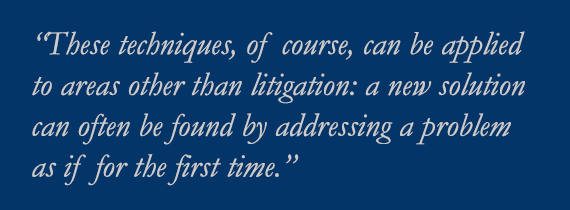Those who handle accident cases are routinely called upon to answer a simple question: how can we establish through admissible evidence that our side of the case should prevail?
Each case we accept can be seen as a new and previously untested problem that requires certain steps to be taken before a successful outcome can be reached. For each case we must ask: are we using the correct strategy? The initial response is to use techniques and methods that have worked well in the past.
The Einstellung Effect refers to an error in creative problem solving where simpler and more effective solutions are ignored in favor of more cumbersome solutions that are used simply because they worked previously.
This error in thinking was first identified in the year 1942. It was then that Abraham Luchins conducted his famous water jar test in which he asked participants to come up with ways to figure out how to measure a certain amount of water using three jars of different sizes. Those who employed a method they previously used did worse than those who were not exposed to a prior method.
“Despite the presence of a simpler solution (A + C), subjects in the experimental group tended to give the lengthier solution in lieu of the shorter one. Instead of simply filling up Jars A and C, most subjects from the experimental group preferred the previous method of B − A − 2C, whereas virtually all of the control group used the simpler solution. Interestingly, when Luchins gave experimental group subjects the warning, “Don’t be blind,” over half of them used the simplest solution to the remaining problems. Thus, this warning helped reduce the prevalence of the Einstellung effect among the experimental group.”[1]
Simply adding two components gave the correct solution but this more effective solution was ignored because the old method of solving the problem was utilized. The Einstellung Effect colors our litigation strategy as well and makes us less effective: we ignore simple solutions in favor of older, less effective techniques.
For example, in a typical car accident case the tendency is to focus on the behavior of the driver—e.g., defendant’s failure to brake, failure to yield, etc.—instead of other aspects of the case that may explain the driver’s conduct simply and more effectively––e.g., cell phone records, the presence of others in the car, the driver’s state of mind, etc. As well, in a typical medical malpractice case, the tendency is to focus on the precise steps taken during the medical care involved instead of asking a more basic question: was the medical procedure at issue even necessary and could the procedure itself have been entirely avoided?
In addition, we may have in our possession a piece of evidence we believe is probative to a specific area while failing to realize it may be relevant to another area as well—e.g., a video of a car accident from a lights camera may reveal facts pertinent to liability as well as damages.
“In the beginner’s mind there are many possibilities, but in the expert’s there are few,” writes Shunryu Suzuki. A “beginner’s mind” is a sound thinking strategy to periodically revisit throughout the duration of a case: what simple solution exists outside of what we normally utilize that explains why we should prevail? What’s a new way to approach this problem apart from anything we’ve previously tried? These techniques, of course, can be applied to areas other than litigation: a new solution can often be found by addressing a problem as if for the first time.
Once the Einstellung Effect is recognized as an invisible yet potentially harmful drain on our creativity we can take steps to lessen its power. We can peel away the layers of the past––“Don’t be blind”––and look anew with fresh eyes. There at last we will find the simple truth, evident and unencumbered, awaiting our discovery.
[1] Einstellung Effect, Wikipedia,
https://en.wikipedia.org/wiki/Einstellung_effect#CITEREFLuchins1942




